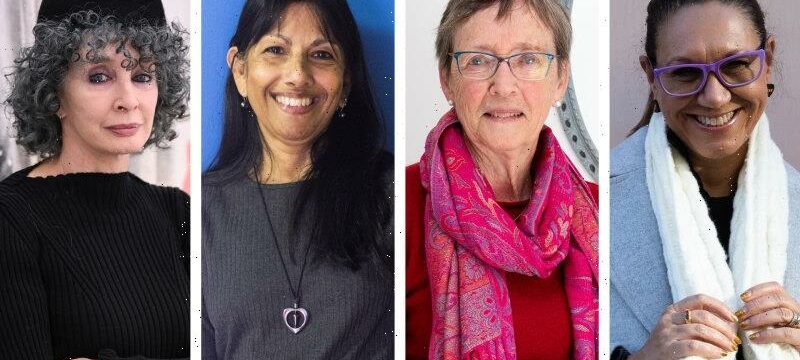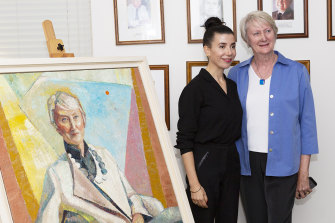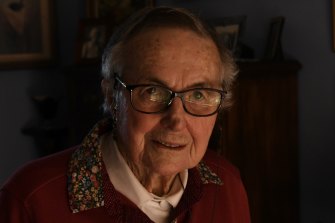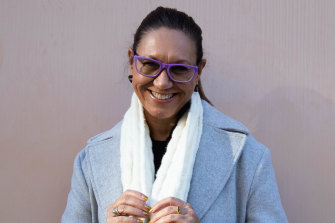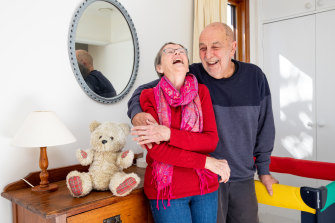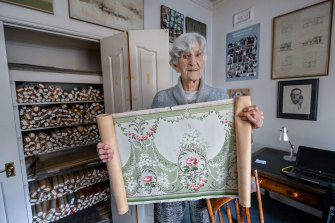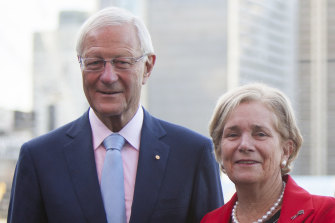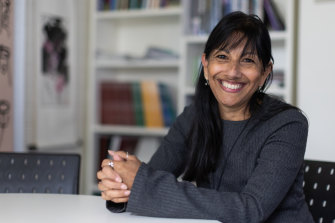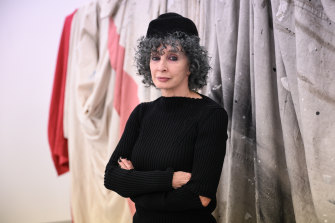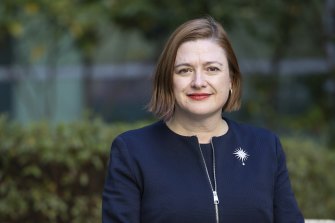Of the 992 Australians honoured in the Queen’s Birthday honours, women make up 40 per cent of recipients in the general division.
The percentage is a dip from the proportion of women honoured in the Australia Day awards this year, and there is still room to catch up, with men having received about 70 per cent of the awards since the Order of Australia was established in 1975.
Every year, big names are on the list: famous sports stars, actors and philanthropists, but most of the honour roll is made up of unsung heroes in local communities.
Here are 10 women overdue for their Queen’s birthday honours.
Emeritus Professor Anne Green
Emeritus Professor Anne Green (right) at the unveiling of her portrait by artist Yvette Coppersmith at the University of Sydney’s School of Physics.Credit:Louise Cooper
Emeritus Professor Anne Green began her scientific career scrutinising the structure of crystals through an electron microscope, but the scale of her interest shifted vastly when she enrolled as the first female PhD student at the University of Sydney’s School of Physics. She ended up mapping the Milky Way and has been awarded the Companion of the Order of Australia (AC).
“I’m a very peaceful person, but I spent most of my astronomy career studying these very violent events when stars blow up,” she says of her work studying the “ecology” of the galaxy.
“You look at what we’re made of: carbon, nitrogen, oxygen. All of those elements were made in the central nuclear factories of stars. We are made of stardust. I mean, that’s just got to be the most interesting and fascinating part of the world.”
Green spent a decade as the director of NSW’s Molonglo Telescope and eventually returned to the University of Sydney as head of the School of Physics becoming the first woman to hold the position. She’s been honoured with a Companion of the Order of Australia in part for her mentoring of women.
“I’m always astonished by the ingenuity and creativity of people,” she said. “I’ve tried to encourage young astronomers and young scientists, especially young women, when given an opportunity to not hold back. Take the challenge.”
Muriel Kathleen Picton
Muriel Picton, a pioneer in women’s cricket, is a recipient this year.Credit:Dean Sewell
Muriel Picton is in disbelief about receiving a Member of the Order of Australia (AM). The women’s cricket pioneer would tell you she doesn’t deserve it despite playing for Australia from 1952 to 1970, including seven years as captain.
“I’m a bit embarrassed about it; I just wasn’t expecting anything like this,” Picton said.
Picton, who also represented Australia in hockey between 1959 and 1962, is being recognised for championing women’s sport in a time when it was completely self-funded and seen as a “hobby” rather than a career for women.
“Of course everything was voluntary — there was no money given to women’s cricket,” Picton said.
Picton is quick to praise the women who came before her and made it possible for her to play.
“There were ones before us that we looked up to — the likes of Mollie Dive and Margaret Peden,” Picton said.
Despite her humble protest, Picton will be receiving her honour, for significant service to cricket as a player, administrator and coach.
Dr Anita Heiss
Author Dr Anita Heiss is being recognised in the Queen’s Birthday Honours Awards for her services to tertiary Indigenous studies and to the arts. Credit:Janie Barrett
The first in her family to go to university, Dr Anita Heiss has become a leader in advocating for Indigenous Australian literature and literacy. When notified she was receiving a Member of the Order of Australia (AM), Heiss had to read the email twice and says she was surprised and humbled.
“I jumped online to see the history and what other First Nations people had been awarded and thought ‘oh wow, I’m up there with all these fabulous people I know and admire’,” she said.
The author of 19 books, Heiss fell in love with reading only while completing her doctorate. “I started reading volumes and volumes of works by Aboriginal authors, and I was inspired to write as a reaction to everything that was on the shelves at university about Aboriginal people,” she said.
Being the first Aboriginal person to graduate with a PhD from Western Sydney University is among Heiss’ proudest achievements. But she is also proud of her achievements in the arts and community projects.
“My proudest achievement in art is carving out a space in Australian publishing as a First Nations author of commercial fiction, and telling our truth in Australian history and our excellence in the contemporary world,” she says.
Carolyn Stedman
Carolyn Stedman, along with husband David, have looked after 74 foster care children over 46 years.Credit:Edwina Pickles
Carolyn Stedman “falls in love” every time she and husband David open the front door of their northern Sydney home to a new foster child.
The couple have homed 74 children, mostly newborns, in temporary foster care over 46 years. It started in 1976, when Carolyn, a then mother of two (she’d go on to have six), heard an urgent callout for foster carers on the radio. After convincing her husband, the pair embarked on a training course and haven’t looked back.
Her work has been recognised with a Medal of the Order of Australia (OAM).
The couple often collect foster children from the neonatal intensive care unit because they are affected by withdrawal symptoms of a parent’s ice or heroin addiction.
“We need to love and nurture them and provide a safe place for them,” she says.
The inevitable farewelling of the foster children, occurring at any point between two weeks to two and a half years, doesn’t get easier.
“Some [departures] are really hard,” she says. “I’ve never really got over that.”
Despite being in her 70s, Carolyn is not giving up any time soon.
“I think when you have a God-given gift, God expects you to use it until you can’t.”
Dr Patricia Margaret Selkirk
Dr Patricia Margaret Selkirk, plant biologist and ecologist, in her home in Turramurra.Credit:Dean Sewell
In a career spanning six decades and more than a dozen Antarctic expeditions, Dr Patricia Selkirk’s work has been integral to our understanding of the effects of climate change on the world’s coldest and driest continent.
The trailblazing plant biologist and ecologist was the first woman to spend a summer at Casey station in 1982/83 and also spent significant time researching the rare sub-Antarctic ecologies of Macquarie Island.
She says the field has changed for the better since she was one of only a handful of women working in the Antarctic.
“People are selected for participation in expeditions on the basis of their expertise, rather than on the basis of whether they’re male or female.”
The Companion of the Order of Australia (AC) recipient says she never set out to be a trailblazer, and it was a curiosity for biology, encouraged by her scientific family, which drew her to the Antarctic, a place that “can tell us a great deal about what’s happening in this changing world”.
An expert in the moss and liverworts that have benefited from the rapid retreat of ice from the Antarctic continent, Dr Selkirk hopes her AC will draw attention to the effects of climate change on a still relatively unknown continent.
Phyllis Murphy
Phyllis Murphy is being awarded a Queen’s birthday honour for her heritage work in Melbourne. Credit:Joe Armao
Phyllis Murphy said being “very tall” meant she wasn’t easily intimidated by men when she was one of only two women in her graduating architecture class of 1949.
Perhaps it’s that same resilience that propelled her to become a significant figure in the Australian architecture world, for which she is being honoured for her significant service and heritage conservation by becoming a Member of the Order of Australia (AM).
“I very much appreciate it, and was rather surprised,” the 98-year-old said of her honour. “I think it’s something that you have to be very grateful for.”
Murphy, with her husband and two other architects, was responsible for the 1956 Olympic Swimming Pool in Melbourne, which in its time was a “new idea in construction”. She went on to work for the National Trust, restoring many of Melbourne’s heritage-listed buildings such as the Collingwood Town Hall and La Trobe’s Cottage.
Murphy’s mark on Australia’s architectural world can be seen in many of the buildings around Melbourne, and despite this, she argues that she does not really have a legacy.
“As time goes on, only the most remarkable people keep being remembered,” Murphy said.
Murphy’s impact on architecture in Australia, particularly in Melbourne, will not be forgotten.
Gina Fairfax
Gina Fairfax, pictured with husband Tim, is recognised in this years’ Queen’s Birthday Honours.Credit:Tammy Law
Gina Fairfax suspects people would be surprised that she has been recognised for her service to philanthropy, rural Australia and the arts. But no one is more surprised than her.
She is awarded the highest honour, a Companion (AC) in the General Division of the Order of Australia, for her service to the community in leadership roles and charitable organisations “as an advocate for philanthropy, to arts administration and to regional development”.
Speaking from Brisbane, Fairfax says the guiding principle for her work has been to make sure country areas do not miss out and “not have what people in the city have”, particularly regional communities’ access to the arts.
“They are all getting out there, these [art organisations], and it’s wonderful to know how appreciative [regional populations] all are.”
A philanthropist through her family’s organisation, the Tim Fairfax Family Foundation, Fairfax is known for her “quiet, intelligent advocacy” for regional issues, particularly in supporting remote Indigenous communities.
“It’s a huge honour” to receive the recognition, she says, “especially in this year of the Queen’s jubilee. It’s an honour I’m delighted to receive and I’m very grateful for the award.”
Professor Cheryl Dissanayake
Professor Cheryl Dissanayake, founding director and inaugural chair of the Olga Tennison Autism Research Centre at Latrobe University.Credit:Jason South
Cheryl Dissanayake’s first encounter with autism was in the 1979 film Son-Rise, about a boy who makes a “complete recovery” from severe autism.
Since then, she has gone on to become a world-class expert in the field, and mentor to a new generation of researchers with a lived experience of the developmental condition also known as autism spectrum disorder (ASD). Her work has been recognised with a Member of the Order of Australia (AM).
When Dissanayake began her PhD in 1984, autism was believed to be just one acute condition, and research was primarily focused on childhood intervention. Now, she says, ASD is understood as a range of conditions that are different in every person.
Focusing on only acute cases meant that many people, especially women, missed out on a diagnosis. Although fewer women are diagnosed with ASD than men, women with lived experience of autism are informing the next generation of research in the field.
As the founding director of the Olga Tennison Autism Research Centre, Dissanayake says it is a privilege to supervise and learn from current PhD candidates with autism. All are women.
“They’re the experts, aren’t they? They’re living in their own body,” she says. “Learning from them about being autistic is just very different from what we read in the academic literature.”
Anna Schwartz
Anna Schwartz is a recipient of the Queen’s Birthday Honours awards. Credit:Joe Armao
Anna Schwartz is a gallerist and influential figure in the Australian art scene who says her award is an acknowledgement of the cultural position that her gallery occupies.
“I feel it’s an acknowledgement of the sector of artists that I’ve worked with for years,” she says. “I feel a great sense of satisfaction that their work is becoming integrated into the culture.”
Schwartz received the news of her Member of the Order of Australia (AM) by letter, and, being the type of person to do things straight away, opened it immediately.
Making artwork that is protagonistic and challenging viable in contemporary Australia is one thing Schwartz is most proud of. “I’m proud of creating an audience and for that audience to understand the value of the art that I’ve been able to present in my gallery,” she says.
Schwartz says the role of private galleries is to provide visibility to artists, but that they are often underestimated. “The private gallery is not acknowledged to the degree that it should be, which is one of the reasons that I’m pleased to accept this award,” she says.
In 40 years, Schwartz says Australia’s views of what art is and how it relates to their lives have changed: “People are interested in the art of their time to a degree that they weren’t when I first started the gallery.”
Professor Tanya Monro
Professor Tanya Monro, chief defence scientist, received a Companion of the Order of Australia honour for her service to science, technology, research and innovation.Credit:Alex Ellinghausen
Australia’s first female chief defence scientist, Companion of the Order of Australia recipient Professor Tanya Monro (AC), spent her childhood playing the cello in her Bankstown home in south-west Sydney and won a pipe organ scholarship to SCEGGS Darlinghurst. But her year 9 physics teacher set her eyes on the stars.
“I realised that the maths I’d always loved was the language of the universe and physics was my calling,” she says.
Munro went on to specialise in photonics, a field about “harnessing and controlling and generating light”. She has published 600 scientific papers and supervised 50 PhD students in her career.
One of Monro’s first tasks in Defence was developing optical fibres that could sense aircraft corrosion just by “sending photons scurrying around an aircraft”. The same technology can be applied to testing the quality of wine stored in barrels and monitoring the environment of IVF embryos. Monro oversees 2100 researchers driving the future of Australia’s defence capabilities and the “disruptive tech” that will revolutionise the nature of conflict.
Monro brings the creative spark she developed on her cello strings to the role and wants to drive more passionate people into STEM, where she says 70 per cent of future jobs lie.
“My awakening was realising that science is actually a creative pursuit,” she says. “For me, it’s always been about the art of the possible.”
The Morning Edition newsletter is our guide to the day’s most important and interesting stories, analysis and insights. Sign up here.
Most Viewed in National
From our partners
Source: Read Full Article
